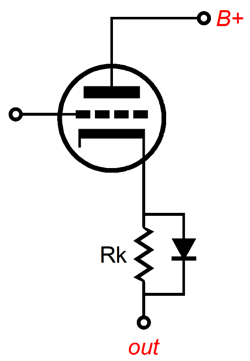This is just a general question. I worked on a Marshall JCM 800 , 2210, I think it was. It's fixed and already gone. What is the purpose of a diode in parralel with the cathode resistor on one of the preamp tubes ? A 12ax7. V 3 if I remember. Thanks.
Ad Widget
Collapse
Announcement
Collapse
No announcement yet.
Cathode diode?
Collapse
X
-
To go into a little more explanation...
That diode is a 1n4007 "pointed" at ground (cathode to ground). In that position there will be the standard diode voltage drop that remains present on the cathode. So, about .7V? The diode also has a very low AC resistance (impedance) and this amounts to a "fully bypassed cathode" such as would happen with a large value parallel capacitor on the cathode circuit. It is also paralleled by a 10k resistor which will NEVER actually be in circuit since it is swamped by the diode in all respects and I honestly can't figure out why it is included in the circuit. So, the bias on that preamp stage is .7V (plus or minus relative to the specific 1n4007 diode I suppose) and fully bypassed of any AC at the cathode. As far as I can tell the purpose of paralleling the components, which is what you asked about, is almost entirely moot. The diode is the 95+% functioning component in control of the circumstances for that circuit and the 10k resistor is doing almost nothing. I seriously doubt you would notice if you snipped it out. The resistor may be there as some sort of shared current measure. But honestly, at 10k it's not doing dick and the voltage/current rating on a 1n4007 diode relative the circuit requirements are way over anything that resistor could mitigate. JM2C"Take two placebos, works twice as well." Enzo
"Now get off my lawn with your silicooties and boom-chucka speakers and computers masquerading as amplifiers" Justin Thomas
"If you're not interested in opinions and the experience of others, why even start a thread?
You can't just expect consent." Helmholtz
Comment
-
The cathode resistor 10k defined the working point (bias) for 12AX7
1N4007 (optional) parallel to the cathode resistor 10k limits the cathode voltage that it is not greater from 0.7V
http://drtube.com/schematics/marshall/jcm800pr.gif
http://drtube.com/schematics/marshall/4010prem.gif
Useful links
http://www.aikenamps.com/index.php/designing-common-cathode-triode-amplifiers
http://music-electronics-forum.com/t24553/#post458676
Designing Tube Preamps for Guitar and Bass - 2009Last edited by vintagekiki; 07-04-2017, 05:32 PM.It's All Over Now
Comment
-
I have "Take two placebos, works twice as well." Enzo
"Take two placebos, works twice as well." Enzo
"Now get off my lawn with your silicooties and boom-chucka speakers and computers masquerading as amplifiers" Justin Thomas
"If you're not interested in opinions and the experience of others, why even start a thread?
You can't just expect consent." Helmholtz
Comment
-
Nice. Good tutorial. But... In the above arrangement for the Marshall schem no "two transconductances" are ever met by the parallel diode/resistor arrangement. The 10k resistor is invariably swamped by the .7V forward voltage of the 1n4007 and NEVER acts as the primary voltage elevation because at 10k .7V is a lot less than any standing voltage if the 10k were acting alone. That was my point. I very much understand the principal behind a diode acting as a shunt relative to a given resistance elevated voltage WRT cathode circuits. In fact if you read around the forum I'm somewhat credited for it (though I deny any originality at every turn). The Marshall circuit absolutely isn't doing anything like that. Which is why I wondered openly about the relevance of the 10k resistor in the circuit."Take two placebos, works twice as well." Enzo
"Now get off my lawn with your silicooties and boom-chucka speakers and computers masquerading as amplifiers" Justin Thomas
"If you're not interested in opinions and the experience of others, why even start a thread?
You can't just expect consent." Helmholtz
Comment
-
It probably has something to do with how a diode-biased stage reacts to being overdriven to the point of cutoff. I've typically seen people recommend a small-ish capacitor in parallel with the diode instead of a resistor.
Or it could just be they already had the PCB set up for typical R||C cathode bias and just specified whoever/whatever populated the board to use a diode instead of the cap.
Comment
-
To further clarify, the voltage on your typical cathode biased preamp stage CHANGES with the grid signal - in-phase.. unless fully bypassed with a capacitor. If bypassed with a cap the DC bias can also shift...biasing colder as the Vk rises. The diode keeps the cathode voltage steady at .7v allowing the gain to increase since the cathode is no longer "following" the grid signal nor bias-shifting.
Comment
-
A quick check on the curve tracer shows a 1N4001 drops 0.56V @ 1mA and 0.6V @ 2mA. (It's 85F back there.) Doing the math in my head puts the impedance of the diode around 40 Ohms. I'll bet the diode adds some nice even order THD to what the tube already produces.WARNING! Musical Instrument amplifiers contain lethal voltages and can retain them even when unplugged. Refer service to qualified personnel.
REMEMBER: Everybody knows that smokin' ain't allowed in school !
Comment
-
-
A closer examination of the circuit is in order. The schematic I found dated 18-5-88 shows a 470K plate resistor, a 1 Meg gain pot and a diode clamp for a load. Not to mention the odd ball IC, CA3046... a channel switch?WARNING! Musical Instrument amplifiers contain lethal voltages and can retain them even when unplugged. Refer service to qualified personnel.
REMEMBER: Everybody knows that smokin' ain't allowed in school !
Comment


Comment